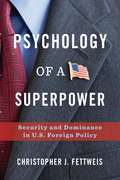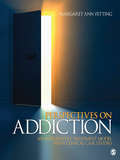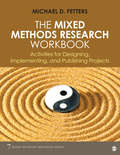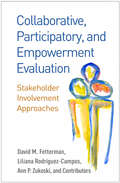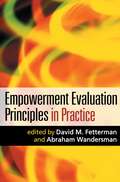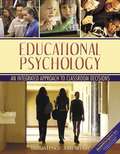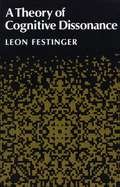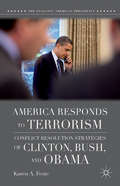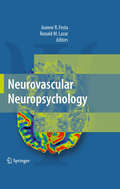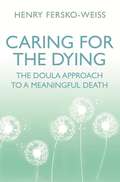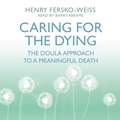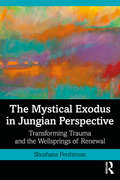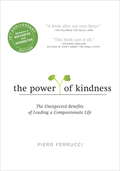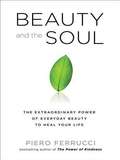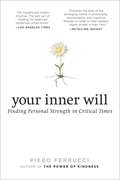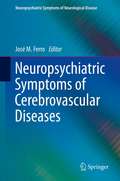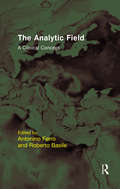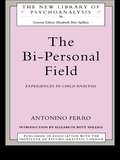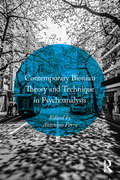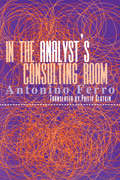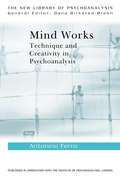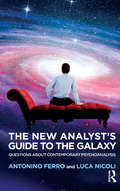- Table View
- List View
Psychology of a Superpower: Security and Dominance in U.S. Foreign Policy
by Christopher FettweisWith the collapse of the Soviet Union, the United States was left as the world’s sole superpower, which was the dawn of an international order known as unipolarity. The ramifications of imbalanced power extend around the globe—including the country at the center. What has the sudden realization that it stands alone atop the international hierarchy done to the United States? In Psychology of a Superpower, Christopher J. Fettweis examines how unipolarity affects the way U.S. leaders conceive of their role, make strategy, and perceive America’s place in the world.Combining security, strategy, and psychology, Fettweis investigates how the idea of being number one affects the decision making of America’s foreign-policy elite. He examines the role the United States plays in providing global common goods, such as peace and security; the effect of the Cold War’s end on nuclear-weapon strategy and policy; the psychological consequences of unbalanced power; and the grand strategies that have emerged in unipolarity. Drawing on psychology’s insights into the psychological and behavioral consequences of unchecked power, Fettweis brings new insight to political science’s policy-analysis toolkit. He also considers the prospect of the end of unipolarity, offering a challenge to widely held perceptions of American indispensability and asking whether the unipolar moment is worth trying to save. Psychology of a Superpower is a provocative rethinking of the risks and opportunities of the global position of the United States, with significant consequences for U.S. strategy, character, and identity.
Perspectives on Addiction: An Integrative Treatment Model with Clinical Case Studies
by Margaret A. FettingPerspectives on Addiction presents a comprehensive, rigorous, and reflective overview of the complex and controversial field of chemical dependency. It is designed for students and clinicians who come in contact with and treat individuals and families struggling with the causes and consequences of substance use disorders. The user-friendly approach to serious content encourages active participation in the learning experience and is designed to have a personal, professional, educational and treatment impact. Readers will develop a novel appreciation for a human desire that pleasures, confounds, and destroys.
The Mixed Methods Research Workbook: Activities for Designing, Implementing, and Publishing Projects (Mixed Methods Research Series #7)
by Michael D. FettersWritten by Michael D. Fetters, one of the leading scholars in the field and co-editor of the Journal of Mixed Methods Research, The Mixed Methods Research Workbook: Activities for Designing, Implementing, and Publishing Projects is the perfect tool for doctoral students and researchers who want support throughout their research project, as well as a practical way to apply the knowledge they’ve learned. With The Mixed Methods Research Workbook, you’ll be ready to tackle your mixed methods research project with confidence. Each chapter follows a familiar framework, starting with learning objectives for each piece of the mixed methods process. Readers have ample space in this text to write notes, fill out activities, and begin their process of actively designing and writing up a mixed methods study. This easy-to follow process gives readers an immediate structure to their projects. Exemplar boxes provide a starting framework, with the text encouraging deeper reflection on mixed methods challenges and opportunities. Stories from the field illuminate struggles and suggestions with the benefit of hindsight. Checklists at the end of each chapter help readers stay organized and key resources provide up-to-date lists of material for further study. From start to finish, readers can follow along with this text as they work on their projects. The text begins by assisting readers in identifying topics and conducting literature reviews in the context of mixed methods, zeroing in to address mixed-methods-specific challenges like integration, leveraging advantages of both qualitative and quantitative methods, and incorporating theory and personal backgrounds. Identifying data sources helps readers organize their data collection. Two chapters on research designs structure the data collection process with procedural diagrams. A unique chapter on mixed methods sampling offers application through basic and advanced designs. The book illustrates integrating and implementing mixed methods designs with practical advice for each of stage of the process. Ethics in a mixed methods context readies readers for the research protocol stage. Several chapters fully explicate the data analysis process, including developing a joint display, a state-of-the-art procedure for analysis and presentation of findings. Closing out the process, the text tackles quality and evaluation in mixed methods studies, preparing your study for publication, and writing up your article.
The Mixed Methods Research Workbook: Activities for Designing, Implementing, and Publishing Projects (Mixed Methods Research Series #7)
by Michael D. FettersWritten by Michael D. Fetters, one of the leading scholars in the field and co-editor of the Journal of Mixed Methods Research, The Mixed Methods Research Workbook: Activities for Designing, Implementing, and Publishing Projects is the perfect tool for doctoral students and researchers who want support throughout their research project, as well as a practical way to apply the knowledge they’ve learned. With The Mixed Methods Research Workbook, you’ll be ready to tackle your mixed methods research project with confidence. Each chapter follows a familiar framework, starting with learning objectives for each piece of the mixed methods process. Readers have ample space in this text to write notes, fill out activities, and begin their process of actively designing and writing up a mixed methods study. This easy-to follow process gives readers an immediate structure to their projects. Exemplar boxes provide a starting framework, with the text encouraging deeper reflection on mixed methods challenges and opportunities. Stories from the field illuminate struggles and suggestions with the benefit of hindsight. Checklists at the end of each chapter help readers stay organized and key resources provide up-to-date lists of material for further study. From start to finish, readers can follow along with this text as they work on their projects. The text begins by assisting readers in identifying topics and conducting literature reviews in the context of mixed methods, zeroing in to address mixed-methods-specific challenges like integration, leveraging advantages of both qualitative and quantitative methods, and incorporating theory and personal backgrounds. Identifying data sources helps readers organize their data collection. Two chapters on research designs structure the data collection process with procedural diagrams. A unique chapter on mixed methods sampling offers application through basic and advanced designs. The book illustrates integrating and implementing mixed methods designs with practical advice for each of stage of the process. Ethics in a mixed methods context readies readers for the research protocol stage. Several chapters fully explicate the data analysis process, including developing a joint display, a state-of-the-art procedure for analysis and presentation of findings. Closing out the process, the text tackles quality and evaluation in mixed methods studies, preparing your study for publication, and writing up your article.
Collaborative, Participatory, and Empowerment Evaluation: Stakeholder Involvement Approaches
by David M. Fetterman Liliana Rodríguez-Campos Ann P. Zukoski And ContributorsFrom pioneering leaders in the field, this is the first book to provide a solid foundation for three major stakeholder involvement approaches: collaborative, participatory, and empowerment evaluation. Highlighting differences among the approaches, the authors focus on the role of the evaluator, who may be in charge of the evaluation, share control, or serve as a "critical friend," leaving stakeholders in control. Practitioners are guided to select and implement the most appropriate framework for the purpose and scope of a given evaluation and the needs of community members and funders. For each approach, a chapter on essential features is followed by two chapters presenting actual sample evaluations--for example, early childhood and community health initiatives, an aquarium, a project with Google, and more. The concluding chapter discusses similarities and circumstances in which the approaches can be combined.
Empowerment Evaluation Principles in Practice
by David FettermanWhat principles should guide an empowerment evaluation? And how can these principles actually be put into practice? One of the primary tasks in an empowerment evaluation (EE) is to increase the capacity of program stakeholders to plan, implement, and evaluate their own programs. This book presents the most current formulation of the 10 principles of EE and provides professionals and students with the tools to put these principles into practice. Through case studies of diverse evaluation projects--including community health foundation initiatives, school district programs, and a $15 million corporate program aimed at bridging the digital divide--the founder and leading proponents of EE clarify key concepts and discuss important lessons learned. Coverage includes how to balance program improvement efforts with accountability requirements; how EE can be used to guide standards-based work; how to use EE in a learning organization; the differences among empowerment, collaborative, and participatory evaluation; and much more.
Educational Psychology: An Integrated Approach to Classroom Decisions
by Thomas Fetsco John McclureDiscusses educational psychology in theory and practice.
A Theory Of Cognitive Dissonance
by Leon FestingerLeon Festinger's theory of cognitive dissonance has been widely recognized for its important and influential concepts in areas of motivation and social psychology. The theory of dissonance is here applied to the problem of why partial reward, delay of reward , and effort expenditure during training result in increased resistance to extinction. The author contends that a state of impasse exists within learning theory largely because some of its major assumptions stand in apparent opposition to cetain well-established experimental results. The book puts forward a new theory that seems to reconcile these data and assumptions. This new theory can account for data with which other theories have difficulty: it integrates empirical phenomena that have been regarded as unrelated, and it is supported by the results of experiments designed specifically to test its implications. These experiments are fully described in the text.
America Responds to Terrorism: Conflict Resolution Strategies of Clinton, Bush, and Obama (The Evolving American Presidency)
by Karen A. FesteFeste develops a framework of terrorism termination dynamics constructed from empirical cases and applies it to the current al Qaeda problem to offer a new method for tracking development of terrorist episodes with implications for U. S. foreign policy.
Neurovascular Neuropsychology
by Joanne Festa Ronald Lazar J. P. MohrNeurovascular diseases and conditions, and their associated risk factors, represent a significant cause of cognitive disability in the United States and throughout the world. In the USA alone there are 750,000 new strokes each year, representing the number one cause of disability in the country. Hypertension, found in approximately 50 million Americans, has been shown to be associated with alterations of cognitive function, even in the absence of stroke and dementia. Recent studies of neurovascular disease have now revealed that neuropsychological function may be a more sensitive measure of brain integrity than coordination, motor or sensory function and correlates will with functional outcome measures. Neurovascular Neuropsychology focuses on focal and diffuse neurovascular disease in addition to systemic conditions in which cognition and behavior have been uniquely associated with different pathologic states. With an increasing number of patients being treated by healthcare professionals, Neurovascular Neuropsychology will prove to be a strong reference to consult in regards to neuropsychological syndromes.
Caring for the Dying: The Doula Approach to a Meaningful Death
by Henry Fersko-WeissA gentle guide for end of life care aimed at families and caregivers.Caring for the Dying describes a whole new way to approach death and dying. It explores how the dying and their families can bring deep meaning and great comfort to the care given at the end of a life. Created by Henry Fersko-Weiss, the end-of-life doula model is adapted from the work of birth doulas and helps the dying to find meaning in their life, express that meaning in powerful and beautiful legacies, and plan for the final days. The approach calls for around-the-clock vigil care, so the dying person and their family have the emotional and spiritual support they need along with guidance on signs and symptoms of dying. It also covers the work of reprocessing a death with the family afterward and the early work of grieving.Emphasis is placed on the space around the dying person and encourages the use of touch, guided imagery, and ritual during the dying process. Throughout the book Fersko-Weiss tells amazing and encouraging stories of the people he has cared for, as well as stories that come from doulas he has trained and worked with over the years.The guidance provided can help a dying person, their family, and caregivers to transform the dying experience from one of fear and despair into one that is uplifting and even life affirming. You will see death in a new light and gain a different perspective on how to help the dying. It may even change the way you live your life right now.
Caring for the Dying: The Doula Approach to a Meaningful Death
by Henry Fersko-WeissA gentle guide for end of life care aimed at families and caregivers.Caring for the Dying describes a whole new way to approach death and dying. It explores how the dying and their families can bring deep meaning and great comfort to the care given at the end of a life. Created by Henry Fersko-Weiss, the end-of-life doula model is adapted from the work of birth doulas and helps the dying to find meaning in their life, express that meaning in powerful and beautiful legacies, and plan for the final days. The approach calls for around-the-clock vigil care, so the dying person and their family have the emotional and spiritual support they need along with guidance on signs and symptoms of dying. It also covers the work of reprocessing a death with the family afterward and the early work of grieving.Emphasis is placed on the space around the dying person and encourages the use of touch, guided imagery, and ritual during the dying process. Throughout the book Fersko-Weiss tells amazing and encouraging stories of the people he has cared for, as well as stories that come from doulas he has trained and worked with over the years.The guidance provided can help a dying person, their family, and caregivers to transform the dying experience from one of fear and despair into one that is uplifting and even life affirming. You will see death in a new light and gain a different perspective on how to help the dying. It may even change the way you live your life right now.Read by Barry Abrams(p) 2017 Tantor Media
The Mystical Exodus in Jungian Perspective: Transforming Trauma and the Wellsprings of Renewal
by Shoshana FershtmanThe Mystical Exodus in Jungian Perspective explores the soul loss that results from personal, collective, and transgenerational trauma and the healing that unfolds through reconnection with the sacred. Personal narratives of disconnection from and reconnection to Jewish collective memory are illuminated by millennia of Jewish mystical wisdom, contemporary Jewish Renewal and feminist theology, and Jungian and trauma theory. The archetypal resonance of the Exodus story guides our exploration. Understanding exile as disconnection from the Divine Self, we follow Moses, keeper of the spiritual fire, and Serach bat Asher, preserver of ancestral memory. We encounter the depths with Joseph, touch collective grief with Lilith, experience the Red Sea crossing and Miriam’s well as psychological rebirth and Sinai as the repatterning of traumatized consciousness. Tracing the reawakening of the qualities of eros and relatedness on the journey out of exile, the book demonstrates how restoring and deepening relationship with the Sacred Feminine helps us to transform collective trauma. This text will be key reading for scholars of Jewish studies, Jungian and post-Jungian studies, feminist spirituality, trauma studies, Jungian analysts and psychotherapists, and those interested in healing from personal and collective trauma.
The Power of Kindness: The Unexpected Benefits of Leading a Compassionate Life
by Piero Ferrucci Dalai Lama"A book after my own heart!"--His Holiness The Dalai LamaThe Power of Kindness is a stirring examination of a simple but profound concept. Piero Ferrucci, one of the world's most respected transpersonal psychologists, explores the many surprising facets of kindness and argues that it is this trait that will not only lead to our own individual happiness and the happiness of those around us, but will guide us in a world that has become cold, anxious, difficult, and frightening.Piero Ferrucci warns against the dangers of "global cooling." As the pace of living grows faster and the impact of new technologies more insistent, communications become hurried and impersonal. The drive for profit overrides the heart. Warmth and genuine presence fade.In eighteen interlocking chapters, Dr. Ferrucci reveals that the kindest people are the most likely to thrive, to enable others to thrive, and to slowly but steadily turn our world away from violence, self-centeredness, and narcissism- and toward love. Writing with a rare combination of sensitivity and intellectual depth, Dr. Ferrucci shows that, ultimately, kindness is not a luxury in our world but rather a necessity for us all.
Beauty and the Soul
by Piero FerrucciThe bestselling author of The Power of Kindnessshows how the ability to appreciate beauty-far from being a luxury or an afterthought-is vital to leading a happy, balanced, and satisfying life. Beauty is all around us-in a flower, a song, the sound of falling water, or a dramatic painting. We often think of it as just "window dressing. " But it's not. It is the balm of our existence, and we cannot live full and satisfying lives without it. Transpersonal psychologist Piero Ferrucci helps us to see everyday beauty in a whole new way-and to understand its powers to guide us through periods of darkness or stress, to speed recovery, to make life feel purposeful. He uses stories, case studies, clinical histories, and anecdotes to explain how different kinds of beauty complement and complete our lives in different ways. So much of the malaise and low-grade depression we may find in our lives and those of people we love is due to our inability to understand the extraordinary power-and necessity-of taking time to "smell the flowers. " Ferrucci shows how we can place ourselves in closer proximity to the therapeutic healing that only beauty can bring.
The Power of Kindness
by Piero FerrucciPiero Ferrucci warns against the dangers of "global cooling. " As the pace of living grows faster and the impact of new technologies more insistent, communications become hurried and impersonal. The drive for profit overrides the heart. Warmth and genuine presence fade. The Power of Kindness is a stirring examination of a simple but profound concept. Piero Ferrucci, one of the world's most respected transpersonal psychologists, explores the many surprising facets of kindness and argues that it is this trait that will not only lead to our own individual happiness and the happiness of those around us, but will guide us in a world that has become cold, anxious, difficult, and frightening. In eighteen interlocking chapters, Dr. Ferrucci reveals that the kindest people are the most likely to thrive, to enable others to thrive, and to slowly but steadily turn our world away from violence, self-centeredness, and narcissism- and toward love. Writing with a rare combination of sensitivity and intellectual depth, Dr. Ferrucci shows that, ultimately, kindness is not a luxury in our world but rather a necessity for us all. .
Your Inner Will
by Piero FerrucciThe bestselling psychotherapist and author of The Power of Kindness offers a concrete program for developing the will--a faculty we greatly need to face life's hurdles and to embark on our most meaningful projects All of us experience periods of gloom, fear, and uncertainty. But we each possess deep reserves of inner strength and wisdom for dealing with such setbacks. Indeed, it is the very arrival of darkened circumstances that can summon our untapped energies. In Your Inner Will, therapist and philosopher Piero Ferrucci explores how to play on the iron chords of our interior selves. In this stirring and deeply practical work, Ferrucci provides a full program for the cultivation of the will by employing insights from classical mythology and wisdom teachings, neuroscience research, case studies, and psychological exercises. Each chapter focuses on a specific aspect of will and is followed by exercises that guide the reader in its development. Chapters include: Mastery, Autonomy, Freedom, Courage, Integrity, and Resilience. Ferrucci describes the pitfalls we face when our inner strength is lacking, and shows us what we can expect when it is healthfully developed. An effective will can guide us in our search for inner freedom; it helps us to take risks and to renew ourselves; it makes us feel strong and confident. Your Inner Will is an immensely practical study that helps readers navigate crises and pursue more purposeful lives.
Neuropsychiatric Symptoms of Cerebrovascular Diseases
by José M. FerroNeuropsychiatric Symptoms of Cerebrovascular Diseases is an up-to-date, comprehensive review of the neuropsychiatry of stroke, by active authorities in the field, with an emphasis on diagnostic and management issues. Neuropsychiatric Symptoms of Cerebrovascular Diseases includes critical appraisal of the methodological aspects and limitations of the current research on the neuropsychiatry of stroke and on unanswered questions/controversies. Pharmacological aspects of management are discussed, to provide robust information on drug dosages, side effects and interaction, in order to enable the reader to manage these patients more safely. Illustrative cases provide real life scenarios that are clinically relevant and engaging to read. Neuropsychiatric Symptoms of Cerebrovascular Diseases is aimed at neurologists, stroke physicians and psychiatrists, and will also be of interest to intensive care doctors, psychologists ad neuropsychologists, research and specialist nurses, clinical researchers and methodologists.
The Analytic Field: A Clinical Concept (The\efpp Monograph Ser.)
by Antonino Ferro Roberto Basile'Until now no book has ever attempted to compare and contrast contributions on analytic field theory and at the same time to explore its clinical and technical implications. This volume is intended for the first time to link together many of these writings and to provide an initial wide-ranging survey of the subject - for it is our contention that a theory of the field in various of its loci can also be inhabited by different theories. A particular aim of this book is to present not only theoretical discussions of field theory, but also contributions on clinical work and technique. For this reason we have given preference to articles with a substantial clinical component which exemplify specific underlying technical theory. In the Babel of psychoanalytic languages, clinical practice is in our view the most effective way of comparing psychoanalytic models.'
The Bi-Personal Field: Experiences in Child Analysis (The New Library of Psychoanalysis #Vol. 38)
by Antonino FerroIn The Bi-Personal Field Antonino Ferro sets out his new conceptual system for analysis, considering not only the inner world of the patient but the continued interaction of that world with the inner world of the analyst. The book takes a fresh look at the main aspects of theory and technique in psychoanalysis in the light of Kleinian developments. It reflects the drastic changes due to the thinking of Bion. Illustrated with numerous detailed clinical examples, the author claims that the basic focus of the analytic relationship is the conscious and unconscious interpersonal/ intersubjective processes going on between the analyst and patient.
Contemporary Bionian Theory and Technique in Psychoanalysis
by Antonino FerroPsychoanalytic theory has developed very rapidly in recent years across many schools of thought. One of the most popular builds on the work of Wilfred Bion. Contemporary Bionian Theory and Technique in Psychoanalysis provides a concise and comprehensive introductory overview of the latest thinking in this area, with additional contemporary theoretical influences from Freud, Klein, and Winnicottian thought. Through explorations of the history, theory, and clinical practice of psychoanalysis, Ferro and contributors reveal the changes and developments it has undergone in the research laboratory of the consulting room. Contemporary Bionian Theory and Technique in Psychoanalysis brings together the theories, clinical practice, and techniques that have gradually been developed in a variety of cultural contexts, exploring how they are understood, clarified and enriched by various analysts in daily practice. The book is circular, opening many paths of access to the reader. It aims to revive an experience of creative dialogue exactly as occurs in analysis when two minds think and dream together to transform each other reciprocally. The book sets forth, for instance, a new model of the mind called the oneiric model, taking inspiration from Bion’s conceptualizations and field theory. Covering central psychoanalytic concepts such as transference, dreams and child analysis, this book provides an excellent introduction to the most important contemporary features of Bionian theory and practice. Contemporary Bionian Theory and Technique in Psychoanalysis will appeal to ppsychoanalysts and psychotherapists in training and practice, as well as students of psychiatry and psychology.
In the Analyst's Consulting Room
by Antonino FerroIn The Bi-Personal Field: Experiences in Child Analysis, Antonino Ferro devised a new model of the relationship between patient and analyst. In the Analyst's Consulting Room complements and develops this model by concentrating on adults.From the standpoint of the "analytic field", Antonino Ferro explores basic psychoanalytic concepts, such as criteria for analysability and ending the analysis, transformations that occur during the session, the impasse and negative therapeutic reactions, sexuality and setting. The author explores certain themes in greater depth, including:* ways in which characters that appear during sessions can be interpreted* continual indications given by the patient during the emotional upheavals of the field* the function of "narrator" which the analyst takes on to mark the boundaries of the possible worlds.Through clinical narrative, Ferro renders Bion's often complex ideas in a very personal and accessible way, making this book invaluable for psychoanalysts, psychotherapists, psychiatrists and psychologists.
Mind Works: Technique and Creativity in Psychoanalysis (The New Library of Psychoanalysis)
by Antonino FerroIs the analyst's mind a factor in the analytic process? In Mind Works Antonino Ferro uses clinical material such as detailed reports of sessions, together with client's analytic histories, to develop Bion’s original findings and illustrate complex concepts in the field of psychoanalytic technique. These concepts include: interpretive modalities the end of analysis psychosomatic pathologies narcissism. Mind Works: Technique and Creativity in Psychoanalysis also suggests that dreaming is a fundamental moment in analytic work, and Ferro discusses how dreams can go beyond the present to become a continuous act of the mind in the waking state, allowing internal and external stimuli to be transformed into thoughts and emotions. Focusing on how the minds of the analyst and the analysand work in psychoanalysis, this book will appeal to psychoanalysts, psychotherapists, and psychiatrists and will be helpful in psychoanalytic and psychotherapeutic work on a day-to-day basis.
The New Analyst's Guide to the Galaxy: Questions about Contemporary Psychoanalysis
by Antonino FerroThis book touches upon many of the key areas of contemporary psychoanalysis: setting, technique, theory, as well as post-Bionian models and the 'Bionian Field Theory'. It is meant to be a self-defence handbook for new, usually young, analysts.
Psychoanalysis and Dreams: Bion, the Field and the Viscera of the Mind
by Antonino FerroPsychoanalysis and Dreams explores some of the cornerstones of Antonino Ferro’s theoretical model but also attempts to extend the dreamlike boundaries of the model. Based on Bion’s theory of alpha function and the analytic field, Ferro has developed his own original theorization of transformations in dreams and of work in the analytic session as a waking dream. Clearly highlighted in the book is Ferro’s theory that transformation in dreams is the activity which is constantly carried out in the mind of the analyst, who nullifies the reality-status of the patient’s communication and considers the patient’s narrative as a dream which must be constructed in real time in the encounter between the two minds at work. At the centre of Ferro's theoretical proposal stands the transition from a psychoanalysis of contents to a psychoanalysis which develops the apparatus for thinking, based on the conception of an unconscious in a perennial state of construction and transformation, which must be dreamed, and which continuously expands as it is dreamed. Psychoanalysis and Dreams is written for practicing and training psychoanalysts, psychotherapists and psychiatrists and will be helpful in everyday psychoanalytic and psychotherapeutic work.
